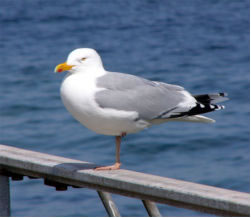
Common Pests – Seaguls
Description
There are several species of Gulls that are often refered to as Seagulls. They are aggressive and noisy birds and can measure up to 68cm from bill to tail, with a wingspan up to 85cm. The two main species that cause problems in the UK are the Herring Gull and the Lesser Black Backed Gull.
The herring gull has a pale grey back and wings with black and white wing tips. It has a red spot on a yellow bill, and its legs are usually pink.
The lesser black-backed gull has a grey to dark grey back and wings. It legs are usually yellow or orange in colour.
Young gulls have a mottled grey and white appearence.
Lifecycle and Habits
Gulls are resourceful and highly-intelligent birds, demonstrating complex methods of communication and a highly-developed social structure. Many colonies display mobbing behaviour, attacking and harrassing would-be predators and other intruders. Certain species, including the herring gull have exhibited tool use behaviour. Many species of gull have learned to co-exist successfully with man and have thrived in human habitats.
Breeding pairs court in April and start nest building from early May onwards. Cliff edges are the natural habitat, but in towns, tall buildings and parapets give gulls safety from predators, whilst also being good places for them to raise their young.
The nests tend to be constructed from straw, grass, twigs, paper and any other materials the gull can conveniently use. These nests can be large and if they are made of material accumulated over several years, they can become quite heavy. This means that if a breeding site is established then the gulls with return year after year.
Pairs usually lay two to three eggs from early May onwards and are defended vigorously by the adults. The eggs take about three weeks to hatch meaning that the first chicks are seen at the beginning of June. The chicks leave the nests in July and take about three years to reach maturity when they will start to breed. Life expectancy for gulls is up to 30 years.
Gulls are social creatures and once roof nesting gets a hold, other gulls will start to move into an area and nest on nearby buildings until they become an established colony. Their loud laughing call is very recognisable.
What Seagulls Eat
Gulls typically feed on fish, worms and invertibrates from the surrounding countryside as well as scavenging rubbish from local refuse sites and elsewhere. They will look for food up to 50 miles from their nest. They are omnivores and will happily eat human food as well as seeking suitable small prey in fields or on the coast, or robbing other birds of their catches.
Problems Linked to Seagulls
Many people find gulls to be a nuisance for a number of reasons including:
- Noise caused by calling gulls.
- Mess caused by their droppings fouling washing, cars, gardens, people and walkways.
- Damage to properties caused by gulls picking at roofing materials and by nests which block gutters or hold moisture against the structure of the building they are on.
- Gulls can be quite aggressive and can dive bomb and swoop on people and animals, even taking food from human hands.
Preventing or dealing with an infestation
Most gulls are protected by law from any interference or action to control them. Inhumane methods of control which could cause suffering to the gulls are illegal. However, they are recognised as being a nuisance and may be controlled by humane methods. Only the owner or the occupier of a building can take action to control them, although you can employ someone else to take action against herring gulls on your behalf.
Not attracting them in the first place is essential –
- don’t feed them.
- don’t leave lids off refuse bins.
- do put refuse sacks out just in time for collection.
There are a variety of ways to control gulls, some are more effective than others and the costs vary.
De-nesting
At the end of every nesting season (usually September) remove all nests and nesting material from your building.
Deterrent
Just removing nests will not solve the problem on its own. The birds will build another nest the following spring. The herring gulls must be discouraged from coming back. This can be done by fitting plastic spikes in the nesting and roosting areas of the roof. Wires or netting can also be effective, but may be unsightly if used on prominent parts of the roof. It is important to make sure that all possible nesting and roosting sites on the roof are protected.
Professional help
It may be advisable to contact a reputable Pest Control company, either for advice, or to carry out a professional treatment. The British Pest Control Association has a list of its member companies on its website, for all areas.